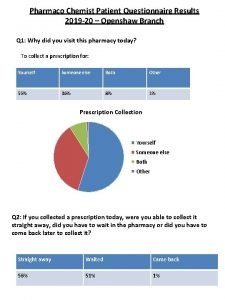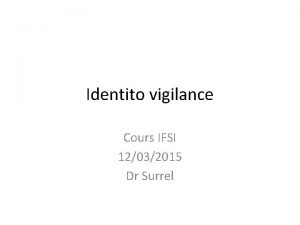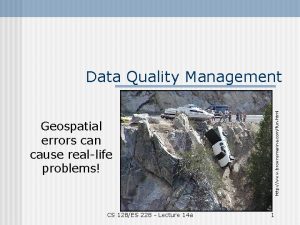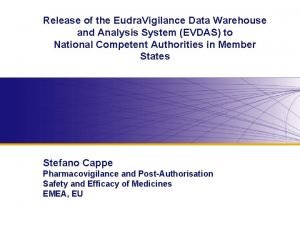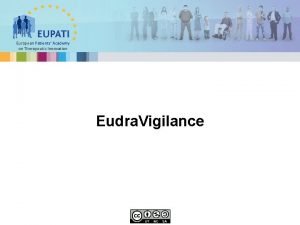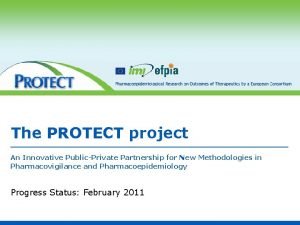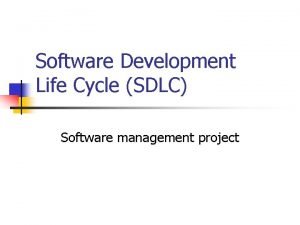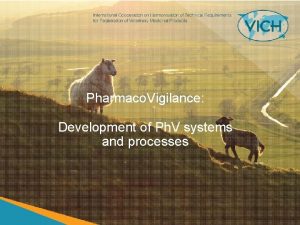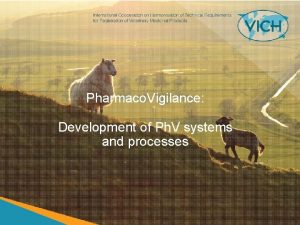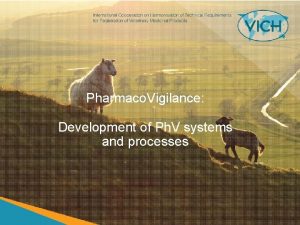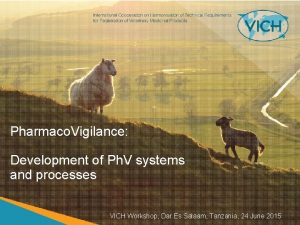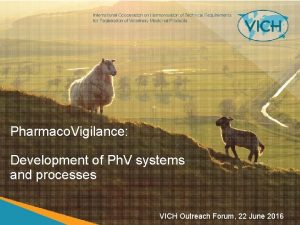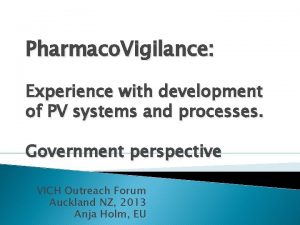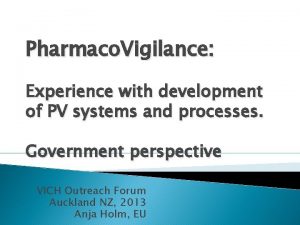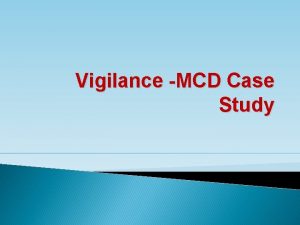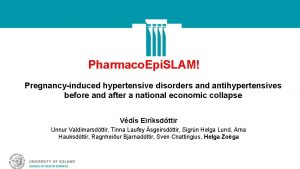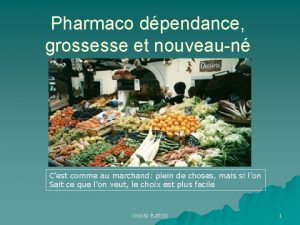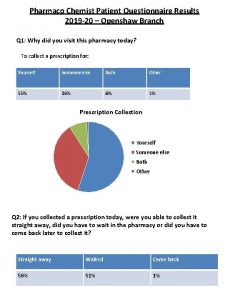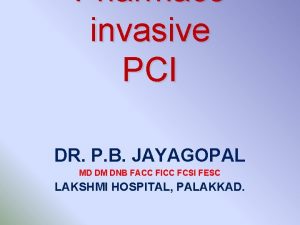Pharmaco Vigilance Development of Ph V systems and


















- Slides: 18

Pharmaco. Vigilance: Development of Ph. V systems and processes VICH Workshop, Dar Es Salaam, Tanzania, 24 June 2015

The goal of pharmacovigilance: Ø Ø 2 Systematic surveillance of all authorised veterinary medicinal products Ensure safe and effective products on the market Fast and proportional action on signals from data analysis Active crisis management with good and open communication

Different levels of Ph. V systems > > > > 3 Estimate the need and expectation depending on Existing Ph. V system or starting new Financial and personnel resources Size of country or region Husbandry production and medicinal use Cooperation with other authorities Legislation

Developing the Ph. V system > Draft legislation framework for Ph. V (avoid details) > Plan Ph. V-system in competent authority: responsibility, level of ambition, cooperation in region, practical work, etc > Define responsibilities and obligations of companies > Align with international definitions > Consult draft plans with stakeholders – companies and vets > Establish necessary documentation and systems • Reporting form for adverse events (AE) • Filing system for AE-reports: Paper small electronic system database • Tools for analysis of data; signal detection; trend analysis; trigger thresholds • Operating procedures • Feedback communication 4

Implementing the Ph. V system > Training? > Communication and awareness plan • • Make companies and vets aware of their obligations • Spread the Ph. V-understanding to vets/users/owners Set deadline for companies to implement in-house systems and procedures (compliance) > Standard reporting form available on website, paper, by telephone, on conferences, etc > Data input management > Start analysing across substances, products, species > Consider using a risk-based approach, where the surveillance intensity is proportional to the expected risk level 5

1. Ph. V requirements in legislation > Definitions of adverse events, scope of Ph. V, surveillance, timelines ~ (VICH GLs) > Obligation for companies to • receive AE-reports from vets/users/owners • analyse the AE-reports and survey their products in general • inform authorities. > Possibility for authorities to • inspect or control that companies comply • analyse data from Ph. V or other sources • take necessary actions based on Ph. V. > Possibility/obligation for vets/users/owners to report directly to authorities. 6

2. Plan Ph. V-system in authority > Define Ph. V-responsibility (who does what) > Realistic ambitions > Aim for regional cooperation if possible, because • large-scale Ph. V-data are more useful and • work-sharing between authorities is beneficial > The company should be responsible for the Ph. V surveillance and Ph. V reporting of their products > The authority should perform controls, product group analysis and request corrective actions 7

The responsibility of the authority > To establish a Ph. V system: • • • collect information evaluate scientifically collate with data on use monitor compliance of companies do inspections take action > Initiate assessment of safety concerns > Define risk management measures or implement conditions and restrictions on products > Encourage reporting of adverse events by vets/users/owners > Communicate safety concerns and mitigation measures 8

Spread the Ph. V-understanding > Encourage reporting: • Receipt letter to vets/users/owners, (and companies) who have reported AEs • Personal response to a few reporters if additional information is needed • Annual Ph. V-report in Vet magazine • Ph. V-presentation for all graduating vets > Education: module on Ph. V in vet university > Ad-hoc presentations at vet conferences and Industry association meetings > AE-reporting form easily available 9

Filing system for AE-reports > From paper small electronic system database > Simple (vet-specific) database with international compatibility is preferable > Tools for analysing data in the database are VERY important! > There are hurdles for a large regional/international database, for example: • IT-compatibility for existing national databases • Product database (same product with different names must be ”linked”) • Who is responsible for analysing data • ”Access to data”-agreements 10

EU experience > Pharmacovigilance system based on • • Spontaneous reports PHV Database and product database Periodic Safety Update Reports (defined reporting dates) Signal detection in database > Follow-up and changes to product information when necessary > Ph. V inspections > Information to vets, users and owners about safe use of products, which is what Ph. V is really about! • (footnote 2015: The EU legislation is currently under revision, also concerning pharmacovigilance requirements) 11

EU-Pharmacovigilance scope > Animal safety • serious and non-serious adverse reactions > Lack of expected efficacy > Off-label use / misuse > Humans reacting after exposure > Violations of residue levels > Potential environmental problems 12

Practical approach in national agency: spontaneous AE-reports Immediately after AE-report is received: > Apply case-number and letter of receipt > Causality assessment by Agency-vet > Decision on action/no-action, or request more information, etc > Ph. V-report forwarded to Company • NB: Protection of personal data of reporter/owner may be required > Filing in national and/or in EU database (at EMA) 13

Practical approach in national agency: PSURs > Periodic safety update reports (PSURs) are received from the companies in a periodic schedule, or on request • includes all AE-reports and • other Ph. V-information since last PSUR and • a benefit-risk evaluation for the product • • 14 Received and assessed for national products Work share for regional products (i. e. EU region) Agreement on fixed data lock-points per substance Letter to company: OK, or occasionally changes in the product information/leaflet, or further investigation requested.

Minimal requirements of an AE report > Identifiable reporter > Animal (species) > Suspected product > Adverse event > However, many more details are desired and possible to fill in to the database/reporting form 15

Other Ph. V information exchange between authorities > Rapid Alert (EUDRANET = Secure intranet system between all EU authorities): sent to all member states, if urgent actions are needed > Non-Urgent Information System: to share and discuss specific trends or cases between member states 16

Reference documents (EU) > Regulation (EC) No 726/2004 (Title III Chapter 3) and > Directive 2001/82/EC (Title VII) > Volume 9 (b) – Guidelines on Pharmacovigilance for Medicinal Products for Veterinary Use. http: //ec. europa. eu/health/files/eudralex/vol-9/vol_9 b_2011 -10. pdf 17

18
 Pharmaco pharmacy
Pharmaco pharmacy Dr surrel
Dr surrel Analysis
Analysis Vigilance awareness week presentation
Vigilance awareness week presentation Eudra vigilance
Eudra vigilance Eudra vigilans
Eudra vigilans Eudra vigilance
Eudra vigilance Constant vigilance
Constant vigilance Vigilance partagée mase
Vigilance partagée mase Decision support systems and intelligent systems
Decision support systems and intelligent systems Initiating and planning systems development projects
Initiating and planning systems development projects Identification of the system for development
Identification of the system for development Initiating and planning systems development projects
Initiating and planning systems development projects Place and development of channel systems
Place and development of channel systems Engineering elegant systems: theory of systems engineering
Engineering elegant systems: theory of systems engineering Embedded systems vs cyber physical systems
Embedded systems vs cyber physical systems Engineering elegant systems: theory of systems engineering
Engineering elegant systems: theory of systems engineering Preliminary investigation in sdlc
Preliminary investigation in sdlc Object oriented development life cycle
Object oriented development life cycle
